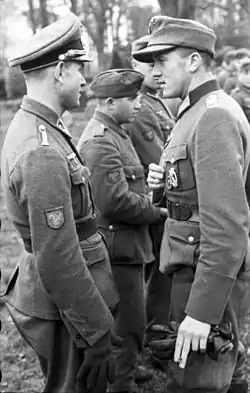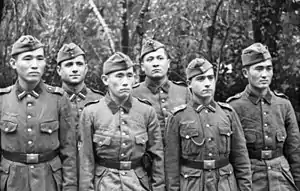東方軍團
東方軍團[1]或稱東方營(德語:、德語:)、「東方部隊」(德語:)、 「東方單位」(德語:)是指在第二次世界大戰期間服務役在納粹德國武裝力量德意志國防軍下來自中亞或蘇聯俘虜或人員的部隊。大多数其中成员属于国防军外籍成员及志愿者.
| Ostlegionen 東方軍團 | |
|---|---|
| Ostlegionen | |
| 國家或地區 | |
| 效忠於 | |
| 直屬 | 德意志國防軍 |
| 參與戰役 | 第二次世界大戰 |

背景
Some members of the Ostlegionen units were conscripted or coerced into serving; others volunteered. Many were former Soviet personnel, recruited from prisoner of war camps. Osttruppen were frequently stationed away from front lines and used for coastal defence or rear-area activities, such as security operations, thus freeing up regular German forces for front-line service. They belonged to two distinct types of units:
- Ost-Bataillone were composed of various nationalities, raised mostly amongst prisoners of war (POW) captured in Eastern Europe, who had been formed into battalion-sized units, which were integrated individually into German combat formations, and;
- Ostlegionen were larger foreign legion-type units raised amongst members of a specific ethnic minority or minorities, and comprising multiple battalions.
Members of Osteinheiten usually faced execution or harsh terms of imprisonment, if they were captured by Soviet forces or repatriated to the USSR by the western Allies.
Ost-Bataillone
Ost-Bataillone wore German uniforms and equipment and were integrated into larger German formations. They began as the private initiatives of individual military commanders. Most were utilized on the Eastern Front and in the Balkans.
In 1944, a number of Ost-Bataillone were stationed in northern France, in anticipation of an Allied invasion of Western Europe. Units that fought in Normandy against Allied Operation Overlord were part of the German 243rd and 709th Static Infantry Divisions, positioned in the vicinity of the Utah, Juno and Sword invasion beaches.[2] Ost-Bataillone were also present in southern France, during the Allied landings codenamed Operation Dragoon (August 1944).
組成東方軍團的不同部隊
| 部隊名稱 | 規模及組成部份 |
|---|---|
| 俄羅斯解放軍 | 投降納粹德國的前蘇聯高級將領安德烈·弗拉索夫以蘇聯戰俘與白俄流亡者(其中有多數是俄國內戰時的反共白軍軍人)所組成的軍隊。 |
| 烏克蘭解放軍 | 主要由烏克蘭人組成,規模約 40,000 人。 |
| 第一哥薩克騎兵師 | 哥薩克志願者組成的騎兵師; 1945年由國防軍轉為隸屬武装黨衛隊。 |
| 格魯吉亞軍團 | 主要由格魯吉亞人組成,規模約十個營。 |
| 亞美尼亞軍團 | 主要由亞美尼亞人組成,規模約十一個營。 |
| 阿塞拜疆軍團 | Initially, Azerbaijanis were included into Kaukasisch-Mohammedanische Legion until 1942 when a separate legion composed of only Azerbaijanis was formed. |
| Caucasian-Mohammedan Legion | Composed of Circassians, Daghestanis, Chechens, Ingushes, and Lezghins. |
| 北高加索和山地高加索軍團 | Consisted of Abkhazians, Circassians, Kabardians, Balkars, Karachais, Chechens, Ingushes, Daghestanis, Kurds, Talyshis, and North Ossetians, separated from the Caucasian-Mohammedan Legion in accordance with the order of 19 February 1942. |
| 突厥斯坦軍團 | 8 battalions, composed of Turkmens, Uzbeks, Kazakhs and other Central Asian nationalities; they saw action as the 162nd Turkoman Division, in Yugoslavia and Italy. |
| 伏爾加韃靼軍團 | Composed of volunteers from Idel-Ural peoples including Tatars, Bashkirs, Chuvashes, Udmurts, and Mordvins. |
| Freiwilligen-Stamm-Division (Regular Volunteer Division) | Established 1944, and consists of Turkic, Azerbaijani, Georgian, Tartar, Cossack, Armenian and other Soviet volunteers, spread over five regiments. Involved in anti-partisan operations against the French Resistance. Known for the Dortan Massacre in July 1944. [3][4][5] |
參見
参考文献
引用
- 环球时报. . 凤凰网. [2021-02-19].
- Ambrose, Stephen. . London: Simon & Schuster. 1997: 34. ISBN 0-7434-4974-6.
- Thomas (2000), p. 11.
- Lieb (2007), pp. 61–62, 119, 310, 338.
- Kedward (1993), p. 280.
来源
- Kedward, Harry Roderick. . Clarendon Press. 1993. ISBN 978-0191591785.
- Lieb, Peter. [Conventional or NS-ideological war. Warfare and anti-partisan fighting in France 1943/44]. R. Oldenbourg Verlag. 2007. ISBN 978-3486579925 (德语).
- Thomas, Nigel. . Osprey Publishing. 2000. ISBN 978-1855327979.

